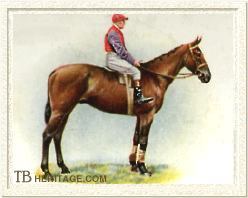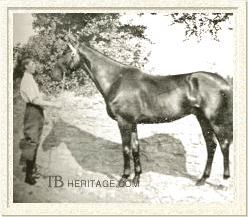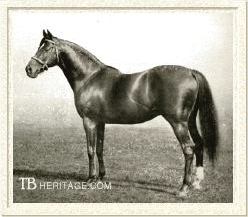|
|
J.J. Maher: The Jumpers

|
|
|
|
| J.J. Maher's two Grand National winners, as well as many other top chasers and hurdlers he bred, came from one family of thoroughbred mares that had been in Ireland since the early 19th century. This family also produced another group of contemporaneous high class steeplechasers developed by another Irish breeder, J. O'Connell Murphy, and some considered that family branch to be superior to the one developed by Maher. The foundation mare of these two branches was an 1849 mare, Chatelaine, who was by Derby, a son of the 1826 St. Leger winner Tarrare, and out of What-Not, a mare by Welcome. |
|
Mount Royal Branch
In 1884 Maher bought a Chatelaine grand-daughter, Mount Royal, from Irish breeder Lord Gormanstown. She was by a good jumping sire, Monarch of the Glen, a son of Stockwell, who later got the 1898 Irish Grand National winner, Porridge. She had duplicate lines (4 x 3) of the great sire and source of speed and good action, Irish Birdcatcher, and the mare Echidna (by Economist), through Stockwell's sire, The Baron, and his full brother, Bandy, Mount Royal's damsire.
Mount Royal had a colt at foot when purchased, by Ingomar--named Citadel, he was developed by Maher into a useful chaser who won the Irish Grand National in 1889. Her second foal was Cyclops, a horse who won at two miles, by Concha (1873, a son of Ascot Gold Cup winner Asteroid), who ran in the 1879 Grand National. |
| CHATELAINE 1849 by Derby |
| AMULET b.f. 1856 by Magnum |
| MAVOURNEEN 1878 by Master Richard |
CORONET b.g. 1881 by Blood Royal
Liverpool Steeplechase |
DIADEM b. f. 1882 by Ingomar
An ancestor of Cottage Rake |
IRELAND ch.c. 1884 by Rostrevor
Liverpool Steeplechase |
INNISFAIL b.c. 1885 by Play Actor
National Hunt Steeplechase |
| ALANNA b.f. 1889 by Kendal |
RATHNALLY g. 1905 by St. Pat
2nd Grand National |
BREEMOUNT'S PRIDE b.f. 1893 by Kendal
Irish Grand National, Lancashire Steeplechase |
| KEERWAN b.f. 1858 by Bandy |
| MOUNT ROYAL b.f. 1877 by Monarch of the Glen |
CITADEL b.g. 1884 by Ingomar
Irish Grand National |
| CINNAMON b.f. 1886 by Concha |
COVERT HACK b.c. 1894 by Hackler
Conyngham Cup (4 Times) |
| BALLYHACK b.g. 1896 by Ireland |
| BALLYMACARNEY b.f. 1897 by Royal Meath |
BALLYHACKLE b.g. 1903 by Hackler
Sefton Steeplechase, Liverpool |
BALLYMACAD b.g. 1907 by Laveno
Grand National |
COVERTCOAT b.c. 1906 by Hackler
Grand National |
| CIRCE br.f. 1889 by Play Actor |
FLAXMAN b.c. 1900 by Hackler
4th Grand National |
OLD FAIRYHOUSE b/br.c. 1902 by Hackler
Grand Military Gold Cup |
CACKLER b/br.c. 1903 by Hackler
Sefton and Champion Steeplechases, Liverpool |
|
Bold type indicates the horse was bred by J.J. Maher.

Ballymacad, winner of the 1917 "War National" at Gatwick, a grandson of Cinnamon bred by J.J. Maher.

Old Fairyhouse, a son of Circe bred by J.J. Maher, won the Grand Military Gold Cup.

Flat racing stayer By Jingo (1914) was a tail-female descendant of Mauvorneen; he sired Stellingo (1926, from Zamorrah), the grandam of one of the best jumpers ever, Cottage Rake.
| |
Cinnamon
In 1886 Mount Royal dropped the bay filly, Cinnamon, also by Concha. Cinnamon was tried unsuccessfully over fences at age 4; to season her, Maher hunted her over her 4-5 year old winter, and she was brought back to race the following season, when she ran a dead heat in a £300 steeplechase. The next year she was started again, placing second in a steeplechase at Fairyhouse, after which she was retired to the stud. Maher sent Cinnamon most frequently to the jumper sire Hackler, who stood just down the road from Maher's Williamstown stables. Of her twelve foals, six were got by Hackler, the others by assorted other jumper sires, the most successful of the latter, in terms of production, being the 1897 bay/brown filly Ballymacarney, by the Grand Steeple-Chase de Paris winner Royal Meath.
Cinnamon's first foal was the 1893 bay/brown filly Brown Hackle, by Hackler. She was a small mare, but a "wonderful" jumper who won two minor races over fences and then was sold to Germany. Her second foal, Covert Hack, also by Hackler, was called "a marvel at Punchestown," having won the four-mile steeplechase Conyngham Cup four times between 1899 and 1903 for his purchaser, English turfite Captain Eustace Loder (owner of Pretty Polly, Spearmint and others). Her third foal, Ballyhack, by the jumper sire Ireland, was purportedly a good horse who was sold to the Duke of Westminster, but broke his leg the first time he raced in England. Ireland (1884, by Rostrevor), incidentally, also descended from Chatelaine.
Her 1897 filly, Ballymacarney, by Royal Meath, jumped a boundary fence when she was nine days old and lost the sight of one eye. Maher kept her for the stud, and from her bred two good 'chasers: the Sefton Steeplechase winner Ballyhackle (1903, by Hackler) and the 1917 "War National" winner Ballymacad (1907, by Laveno). Ballyhackle was favored for the 1913 Aintree Grand National (at 5 to 1), which his "uncle," Covertcoat, won; he came in seventh after a refusal. Cinnamon also produced the filly Ballymacoll (1904, by Hackler), who had a number of useful jumping descendants.
Maher was later to note "Cinnamon's fillies were very unlucky." In addition to Ballymacarney's injury, another of her fillies by Hackler jumped that same boundary fence as foal, and broke her back. An 1899 filly by St. David, called Frankincense, hurt her hock jumping a boundary fence as a yearling, and that ended her future racing career.
At the age of 19 Cinnamon was returned to Hackler for the last time, producing, at age 20, one of her best foals, Covertcoat (1906), a "fairly good-looking horse." He was broken and trained by F. Quinlan at Maher's Williamstown stables at age 3, then developed a lameness-causing spavin. In the fall of 1910, he was lent to a friend of Maher's to hunt, but proved to be a hard puller, difficult to manage, and was returned before the season was through. In the spring of 1911 he won a £500 maiden plate at Punchestown, where he was spotted by Robert Gore, trainer for Sir Charles Assheton-Smith, a jumper owner of some prominence (owner of Cloister and of Jerry M., 1912 Grand National winner, among other jumpers). Maher had already started to shut down his jumper training stable, and soon after his win, Covertcoat was sent to the Dublin Sales, where Gore took the initiative and stayed in the bidding to purchase him for 1,075 guineas, 75 guineas over the maximum he and his employer had previously set. In addition to winning the Grand National of 1913 for Assheton-Smith, Covertcoat won two more races for him, and a total of £3,636.
Circe
In 1889 Mount Royal produced another filly, Circe, by the Irish jumper sire Play Actor, a son of Sterling and damsire of both Jenkinstown (Grand National 1910) and Music Hall (Grand National 1922). Maher felt this filly had enough quality to "breed a Derby winner," but her descendants proved to be much more successful over fences than on the flat, although at least one daughter line, that went to Chile, produced a moderately successful stakes-placed flat runner, Andantino (1951, Iturbide - Andaluza).
Like Cinnamon, Circe was most often bred to Hackler, and those offspring were the most succesful of her twelve foals. Flaxman (1900, by Hackler) placed fourth in Rubio's Grand National (1908) when owned by King Edward VII, and his half-brother Springbok (1901, by Springtime), carrying more weight than those who beat him, placed fifth in the same race; Springbok also ran in the 1910 National, placing in the middle in that race. Another son, Young Buck (1899, by Buckingham) won some good races, but fell during his sole challenge in the Grand National of 1909. Old Fairyhouse (1902, by Hackler) won the Grand Military Gold Cup for his amateur owner-rider, Calverley Bewicke, placing second in other chases, such as the Champion Steeplechase at Liverpool and the Coronation Steeplechase at Hereford. Cackler (1903, by Hackler) was a very good winner, taking both the Sefton and Champion Steeplechases at Liverpool. |
Mauvorneen Branch
The Mauvorneen Branch of this talented jumping family was developed by J. O'Connell Murphy, whose stud put out a large number of high-class steeplechasers. Mauvorneen, born in 1878 from the Chatelaine daughter Amulet, was by Master Richard, a son of Derby winner and stayer Teddington. Mauvorneen was bred to a number of different jumper sires in Ireland, producing sixteen foals before her death in 1907.
Mauvorneen's good sons included Coronet (1881, by Blood Royal) and Ireland (1884, by Rostrevor), both winners of the Liverpool Steeplechase. Ireland, whose sire, Rostrevor (Thormanby - Lady Augusta), also got 1890 Grand National and Lancashire Steeplechase winner Ilex, went on to become a moderately successful jumper sire himself. Another good son was Innisfail (1885), by the previously mentioned Play Actor, who won the National Hunt Steeplechase.
Mavourneen's best daughters included Breemount's Pride (1893, by Kendal), who won both the Irish Grand National and the Lancashire Steeplechase and placed fourth in the 1900 Grand National. Her daughter Alanna (1889, also by Kendal) produced the good gelding Rathnally (1905, by St. Pat), favored for the famous muddy race of the 1911 Grand National, but placing second, after a fall (the only one of the 33 horse field not to fall in that race was the winner, Glenside). Another Mauvorneen daughter, Diadem (1882, by Ingomar) was great-grandam in maternal descent, through daughter Minn (1891, by Atheling) of the top flat racing stayer By Jingo (1914, by Aquascutum), winner of the Ascot Gold Cup and Manchester Cup (twice). Maher later said By Jingo was the only horse he had known that was a "good horse on the flat of a regular 'chaser breed." By Jingo, in the stud, sired the grandam of the three-time Cheltenham Gold Cup winner Cottage Rake.
The Stallions
Maher maintained that Hackler, a son of Petrarch and out of Cambridgeshire Stakes winner Hackness (1878, Albert Victor - Cicely Hacket), was one of the three best chaser sires he had ever known--the other two were Ascetic and My Prince. Hackler had won four races on the flat at Newmarket, and had a "grand front and action...with beautiful straight hind legs, a nice eye and plenty of speed." He also had Melbourne (1834, Humphrey Clinker-Cervantes mare; sire of England's first triple crown winner, West Australian) blood, considered by many chaser breeders and experts to be the most valuable element in a jumping pedigree. Petrarch's sire, Lord Clifden, was out of a Melbourne mare, and Hackness's sire's dam, The Bloomer, was by Melbourne. Hackler was first or second in the leading jumper sire lists for over ten years, and got two Grand National winners--Jenkinstown and the Maher-bred Covertcoat--in addition to a great many other top chasers, such as the dual Irish Grand National winner Little Hack II. His success wasn't limited to jumpers--his daughter, Hackler's Pride won the Cambridgeshire Stakes twice, and the Rous Memorial Stakes at Ascot, among other good wins, and son Flying Hackle (1897, from Damoiselle) was a stayer who won at 12 furlongs and later got a number of good 'chasers and was damsire of Royal Mail (1937 Grand National winner). Hackler stood at James Daly's stud at Hartstown, a few miles from Maher's Williamstown stables, and Maher made extensive and successful use of this horse, particularly with Mount Royal daughters.
Royal Meath, to whom Maher bred Cinnamon in 1896 to produce the mare Ballymacarney, was a good steeplechaser who had won the Conyngham Cup in Ireland in 1889, and the Grand Steeple-Chase de Paris in France in 1890; he had been his stable's first choice to contest at Aintree, but was sidelined and eventually retired due to suspensory problems -- it was his stable-mate, the to-be-famous Cloister, who was then put forward as a candidate for the Grand National from Richard Marsh's stable. Royal Meath was a son of Ascetic (1871, Hermit - Lady Alicia), considered by many to be the greatest 'chaser sire ever, who got three Grand National winners and many other top jumpers. Maher admired Ascetic, and considered him one of the top three jumper sires he had known, describing Ascetic offspring as horses with "good fronts, splendid bone and grand straight hind legs...light of back ribs, and with good action." But by the 1890s, Maher had to settle for sending Cinnamon to Ascetic's best sire son.
|
|

